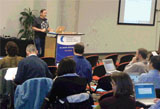All Hands 2011 Declared Best Ever
There was deep relief among all involved in the January 28-29 Temporal Dynamics of Learning Center’s All Hands Meeting that the massive east coast snows failed to cause havoc. With fully half of all TDLC members registered, many suffered power outages, difficult drives and cancelled or missed flights, but a very few actually couldn’t make it.
 The annual gathering, once again hosted by UC San Diego, the Sheraton La Jolla Hotel and the San Diego Supercomputer Center-East, opened with a Trainee Reception and Dinner and closed with a Brainstorming Session/Dinner.
The annual gathering, once again hosted by UC San Diego, the Sheraton La Jolla Hotel and the San Diego Supercomputer Center-East, opened with a Trainee Reception and Dinner and closed with a Brainstorming Session/Dinner.
Heard throughout the annual 2-day event from many of the 100-plus PIs, Trainees and Advisory Board members: “The best ever!”. And while it’s anyone’s guess just what factors may have made for such positive reactions, consider the following:
- On-time shuttle buses, abundant flavorful meals, ample breaks, a seasoned staff, plus warm welcome and concise depiction of the TDLC by UCSD PI and Center Director Gary Cottrell.
- Not only a dynamic Keynote speech but three exceptional keynoters: Gyorgy Buzsaki (Rutgers), Marco Herrera-Valdez (Arizona State) and Terry Sejnowski (Salk Institute and TDLC Co-Director). Plus no panic even with a time hitch due to the inimitable Buzsaki temporarily unable to fly out of Newark.
- And then woven seamlessly into a strong schedule were13 informative presentations on research within the four science Initiatives plus six upbeat Trainee Talks and individual two-hour Initiative planning meetings.
With so much going on, it seemed like an infinite amount to hear, see, absorb and learn. All peppered by probing questions, especially from Javier Movellan (UCSD PI) and Paula Tallal (Rutgers PI and TDLC Co-Director). And then highlights from the very start, with a spirited kickoff by Terry Sejnowski making due reference to “Gyuri’s favorite neurons.” He then introduced us to “The star of the show, the interneuron G42 line … just 5% of all the neurons in the cortex … the cognitive switch in the brain” and emphasized that the interneurons are responsible for organizing information and that the human brain uses a full 20 percent of the energy of our entire body.
Several of the follow-on Initiative presenters cited their visual or auditory research projects, and many included references to the importance of temporal dynamics. Perhaps the most intriguing title was that of UCSD Post-Doctoral Fellow Victor Minces in Initiative 1 (Temporal Dynamics of the World): “Processing a continuous world with a discrete brain.”
Among Initiative 2 (Temporal Dynamics of the Brain) presentations, the standout for concision and originality was that of Isabel Gauthier (Rutgers PI) who utilized animated art to clarify that “Inverted faces are (eventually) processed holistically,” even though some previous papers said no and some said yes.
In Initiative 3, Nicholas Butko (UCSD Grad Student) surprised with his “Active perception” presentation on the next stage of RUBI (Robot Using Bayesian Inference). As he explained, “By ten months of age babies can tell what objects in a room are friendly, inter-actable,” and so RUBI is evolving through methods such as being rewarded for getting its hand close to a target. We were told that the process is synthesizing intelligence into social robots.
And Michael Mozer (University of Colorado Boulder PI) laid out in quick order the details of a human study in Initiative 4 (Principles of the Temporal Dynamics of Learning), which he explained had been undertaken by UCSD Researcher Leanne Chukoskie. Title: “Modeling the time course of implicit learning in visual search.”
The first-ever Trainee Talk Session resulted in six diverse presentations on subjects ranging from cortical activity to object manipulation or recognition and into perceptual and motor learning. Without exception, the presenters -- Peter Stratton (University of Queensland), Alex Simpkins (University of Washington), Christopher Kanan (UCSD and TDLC Trainee Committee Chair), Daniel Leeds (Carnegie Mellon), Markus Plank (UCSD) and Dave Deriso (UCSD) – demonstrated a firm grasp of their subject and kept the attention of the audience:
Following an introduction by Andrea Chiba (UCSD PI and TDLC Co-Director) Keynoter Marco Herrera-Valdez (Arizona State) gave an animated yet serious talk about brain cell studies in rats that delved into spiking activity, temporal bias between cells, time compression in recurring spike sequences and the influence of sequential repetition of behavior.
The final Keynote address was by Gyorgy Buzsaki, about whom it has been written, “For decades he has been expanding the boundaries of what scientists around the world understand about the brain’s ability to process and store information.”
Wasting not a second, the expressive scientist plunged directly and deeply into his favorite subject. To be sure, not everyone got every nuance, but the rarefied world of the firing of different neurons under different conditions came remarkably to life. Also explained was that these rodent brain findings are presumed to prove valid in humans.
![]() by Carolan Gladden
by Carolan Gladden